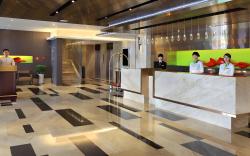Wufeng Lin Family Garden and Lin Hsien-tang Museum Area Introduction
Lin Hsien-tang Museum Mr. Lin Hsien-tang lived in an era of transition between old and new thoughts, possessing the advantages of both traditional and modern intellectuals. The fusion of these two qualities made him one of the greatest figures in Taiwan during the first half of the twentieth century. The museum exhibits historical documents related to the Wu Feng Lin family, ancient manuscripts, the original diaries of Lin Hsien-tang, calligraphy, manuscripts, archives, postcards, and daily necessities, furniture, and significant literary works used by the Wu Feng Lin family in their early years. Stepping into the museum allows visitors to appreciate Taiwan’s handcrafted artistry and exquisite culture, much like reading a biography of Mr. Lin Hsien-tang and a colorful, vivid history of Taiwan. Lai Garden, regarded as the foremost among Taiwan's four famous gardens, is the back garden of the Wu Feng Lin family. Built in 1893 after Mr. Lin Wen-chin passed the imperial examination, it was created out of gratitude to his mother, Lady Luo, for raising him, and named "Lai Garden" based on the story of the old man Lai engaging in colorful clothing to amuse his aging parents. Lai Garden is a beautiful garden set amidst the mountains and waters, featuring national historic sites such as Wu Gui Building, Fei Shuang Drunken Moon Pavilion, Xiaoxi Pond, and Cotton Tree Bridge. These elements cleverly combine nature with culture, creating an exceptionally scenic beauty, making it a renowned spot throughout Taiwan. Rongjing Study was established in 1838 as a residence. In 1887, Lin Wen-chin converted it into a private study (commonly known as a new school), naming it "Rongjing Study" based on the story "Under the Cotton Flower Mirror" from the "Youyang Miscellany." It served as a place for Mr. Lin Hsien-tang to study traditional Chinese scholarship with his family since childhood. The architectural style follows the layout of a traditional academy, with a front courtyard resembling a Confucian temple, a pond, a hall for lectures, and an elegant pavilion in front. It is known as the most complete private academy in Taiwan and was a significant center for Chinese scholarship education in central Taiwan at that time. Jingxun Building is the main residence of the Lin Hsien-tang family, comprising three courtyards with nine openings, commonly described as "the large house with nine compartments and five, three layers totaling one hundred and two doors." It follows a traditional courtyard-style design. Construction began in 1864 by Lin Dian-guo and was completed in three phases, with the main structures finished in 1883 by Lin Wen-chin. Lin Hsien-tang later renovated it during the Japanese occupation, building a grape trellis in front of the hall and reconstructing the original gatehouse, resulting in the scale we see today. The main hall features movable "Bagua doors," "Four Happiness" carvings, and a two-segment "Eagle Hero Independence" double-view painting, along with brackets symbolizing the "Fish Leaping over the Dragon Gate." The sides of the main hall have large vase-shaped doors, signifying peace and safety throughout the seasons, representing a comprehensive traditional architectural style. The above information is provided by the Wu Feng Lin Family Garden and Lin Hsien-tang Museum.











































